More pictures than words this week. After the craziness of snows and floods and Farpoint over these past many weeks, we were so overwhelmed that we felt the need to just get away. We’d visited Monticello, Thomas Jefferson’s mountaintop home, sometime before 2008, and had always intended to go back.
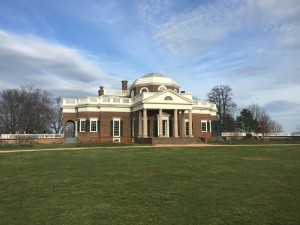 Our first visit was a day trip, which was a bit hectic. Monticello is almost four hours away. This time, we decided to do two nights in nearby Charlottesville, giving us time to relax and reflect alongside visiting the home of one of the only two U.S. presidents whose name I can utter with affection, much less without being riddled by disturbing facial tics.
Our first visit was a day trip, which was a bit hectic. Monticello is almost four hours away. This time, we decided to do two nights in nearby Charlottesville, giving us time to relax and reflect alongside visiting the home of one of the only two U.S. presidents whose name I can utter with affection, much less without being riddled by disturbing facial tics.
We took the more-than-nickel tour. In years past, visitors to Monticello were confined to the first floor, a tour consisting of Jefferson’s apartment, a guest bedroom, and the public rooms like the entry hall, parlor and dining rooms. Recently, Monticello’s guiding foundation added a “behind the scenes” tour, which gives visitors access to the second and third floor living areas used by the rest of Jefferson’s family and their guests. Our host for the weekend informed us that so far only about 4,000 people, out of millions who have visited, have seen these areas.
One of the reasons for this is that, until now, the rooms had not been “interpreted.” Monticello was inhabited by Jefferson for decades, and was ever-changing. Indeed, while living on the property, he actually tore down the whole house and rebuilt. So it’s hard to furnish a room and say, “this is how it always was.” Gathering appropriate furniture and artifacts is a big job, so, for a long time, the upstairs rooms were only used as storage and office space.
But this weekend we were shown 18 of Monticello’s 21 rooms. It’s an amazing place, and it gives you a glimpse into a way of life descended from European feudal traditions, but made uniquely American, in good ways and bad. If you love architecture, history, or just old houses, this tour is well worth both the money and the travel time.
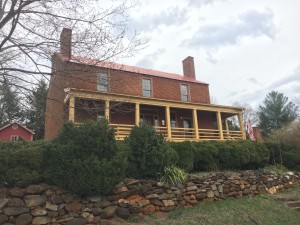 We stayed about ten miles south of Charlottesville, at The Inn at the Crossroads. Built in 1820 by Thomas Jefferson’s nephew, this is an excellent bed & breakfast run by Jim Stern and his family.
We stayed about ten miles south of Charlottesville, at The Inn at the Crossroads. Built in 1820 by Thomas Jefferson’s nephew, this is an excellent bed & breakfast run by Jim Stern and his family.
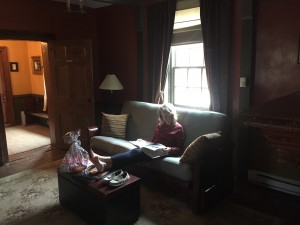 Our suite was the original tavern of the inn. The tavern room was the bedroom, and the sitting room was the single room where the tavern keeper lived with his wife and 16 children. I imagine it was a bit quieter while we were there.
Our suite was the original tavern of the inn. The tavern room was the bedroom, and the sitting room was the single room where the tavern keeper lived with his wife and 16 children. I imagine it was a bit quieter while we were there.
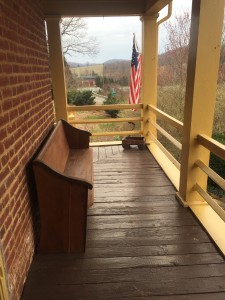 From this porch outside our room, FDR dedicated the George Washington National Forest. FDR being one of the presidents who does cause me to have facial tics, I tried not to hold our shared tenancy against the room. His ghost did not visit me in the night, probably because he knows I’d just start an argument with him.
From this porch outside our room, FDR dedicated the George Washington National Forest. FDR being one of the presidents who does cause me to have facial tics, I tried not to hold our shared tenancy against the room. His ghost did not visit me in the night, probably because he knows I’d just start an argument with him.
The approach to Monticello on a cloudy day. After the tear-down and rebuild, it followed the French style of impersonating a one-story building. There are three floors behind that facade.
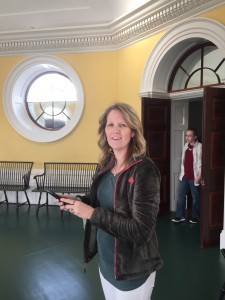 No photography is allowed inside the house, since the objects on display belong to many private collections; but the Dome Room on the 3rd floor is kept empty. Our guide allowed photos there. Interestingly, this room, accessible only via enclosed, winding, 22-inch-wide stairs, once held a pool table. Perhaps it was an Ikea pool table?
No photography is allowed inside the house, since the objects on display belong to many private collections; but the Dome Room on the 3rd floor is kept empty. Our guide allowed photos there. Interestingly, this room, accessible only via enclosed, winding, 22-inch-wide stairs, once held a pool table. Perhaps it was an Ikea pool table?
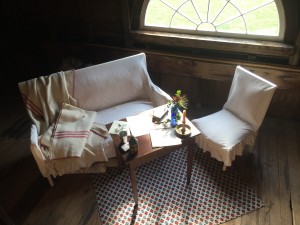 The only furnished “room” we could photograph was the attic space over the South Portico, accessible from double doors off the Dome Room. Jefferson’s granddaughters had deemed it “a fairy palace,” and furnished it so they could have a private space away from the rest of the family.
The only furnished “room” we could photograph was the attic space over the South Portico, accessible from double doors off the Dome Room. Jefferson’s granddaughters had deemed it “a fairy palace,” and furnished it so they could have a private space away from the rest of the family.
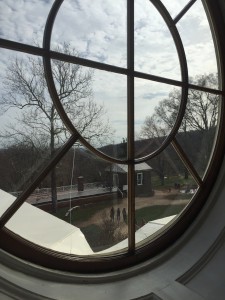 The view from the Dome of the South Pavilion, a tiny building in which the Jeffersons lived as newlyweds.
The view from the Dome of the South Pavilion, a tiny building in which the Jeffersons lived as newlyweds.
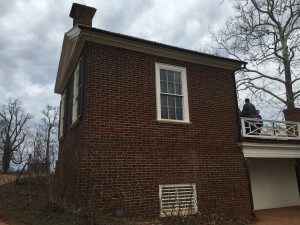 This is a closer view of that same building, accessible from the South Terrace walkway, under which were the kitchen and smokehouse.
This is a closer view of that same building, accessible from the South Terrace walkway, under which were the kitchen and smokehouse.
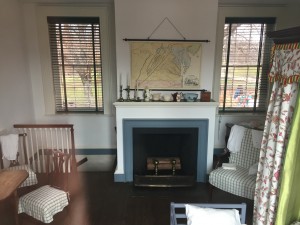 The interior is furnished, as is the interior of the North Pavilion. Tiny houses indeed. (You can’t actually go inside. This is through the window. Zoom in and you’ll probably find ladybugs. They were everywhere.)
The interior is furnished, as is the interior of the North Pavilion. Tiny houses indeed. (You can’t actually go inside. This is through the window. Zoom in and you’ll probably find ladybugs. They were everywhere.)
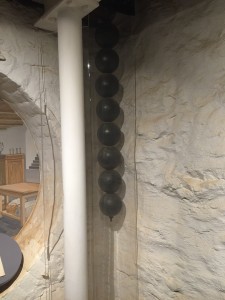 I just think this is neat. The clock in the entry hall, designed by Jefferson, is driven by two sets of weights. He miscalculated the length needed for correct operation, so the weights are actually in the basement, with their lines running through holes in the hall floor. Also in the basement is an excellent exhibit about Monticello’s “downstairs staff,” the enslaved servants who kept the house running. Perhaps not as romantic as Downton Abbey, but the duties of the household staffs were similar.
I just think this is neat. The clock in the entry hall, designed by Jefferson, is driven by two sets of weights. He miscalculated the length needed for correct operation, so the weights are actually in the basement, with their lines running through holes in the hall floor. Also in the basement is an excellent exhibit about Monticello’s “downstairs staff,” the enslaved servants who kept the house running. Perhaps not as romantic as Downton Abbey, but the duties of the household staffs were similar.
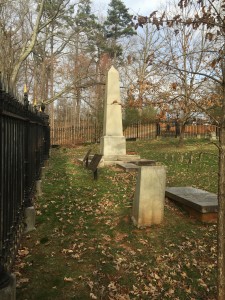 The walk back takes you by Jefferson’s grave marker. By his design, it does not mention his political offices–just the Declaration, the Virginia Freedom of Religion Statute, and the University of Virginia, which he founded.
The walk back takes you by Jefferson’s grave marker. By his design, it does not mention his political offices–just the Declaration, the Virginia Freedom of Religion Statute, and the University of Virginia, which he founded.
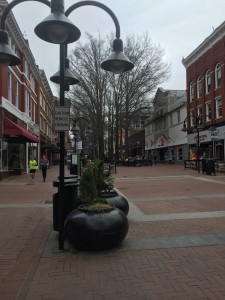 Charlottesville’s Downtown Mall is a pretty amazing place. Four bookstores! And some great places to eat.
Charlottesville’s Downtown Mall is a pretty amazing place. Four bookstores! And some great places to eat.
But, eventually, we had to return home… to the people we had missed.
to the people we had missed.

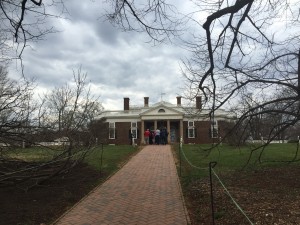
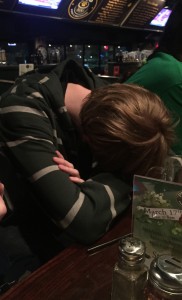
Steve,
I’m so glad you enjoyed my great great great (?) grandfather’s handiwork.
What’s that? Jefferson built Monticello. Well, indeed he did. But he didn’t lay the bricks or pound the nails or make sure everyone was doing what they were supposed to on a minute to minute basis. For that he hired Rueben Bates, fellow architect, builder, slave owner, and my direct ancestor. So, in concept, design, plans, and some of the actual building work Thomas Jefferson did indeed build Monticello. But his foreman as it were was Rueben Bates.